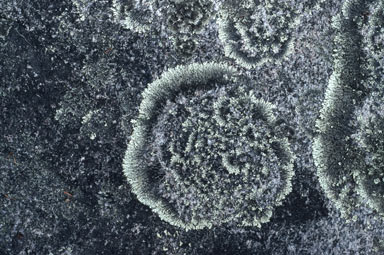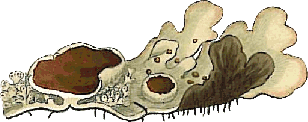 Xanthoparmelia
Xanthoparmelia
Xanthoparmelia taxonomy
By the mid-20th century Parmelia was a large genus of generally foliose lichens and the adjective parmelioid, obviously derived from the genus name, means 'resembling Parmelia'. Numerous species of Parmelia (and of the few other parmelioid genera) had been described but it was clear that the parmelioid lichens were in need of detailed study and in the late 1950s Mason Hale, a lichenologist based at the Smithsonian Institution in Washington D.C., began a study of parmelioid lichens. That Hale began this study can be explained in part by the fact that the Smithsonian's herbarium had a large backlog of unidentified, tropical parmelioid lichens. In addition the area of the eastern United States where Hale did much collecting was rich in parmelioid species and it has also been noted that ...
Perhaps the relative paucity of the Parmelias in Europe had dissuaded the many contemporary European lichenologists from seriously considering the group
.
Over almost four decades (until his death in 1990) Hale, along with various colleagues both within and beyond the United States, produced a revised classification of parmelioid lichens and the work continued after Hale's death. Researching the parmelioid lichens has involved studies of macroscopic and microscopic morphology, chemistry, genetics and ecological preferences. It has been necessary to study existing herbarium collections and to undertake field work to collect parmelioid lichens from areas where they had not yet been collected.
Over time the research showed that, as understood in the mid-20th century, the genus Parmelia was a heterogeneous mix of species but that there were various homogenous sub-groups, each of which could be defined unambiguously by a combination of morphological or chemical features. Some of these sub-groups had been recognized well before Hale's time. For example a subgroup called the Xanthoparmelia section within Parmelia had been defined in 1890.
In the latter half of the 20th century some lichenologists thought such subgroups warranted recognition as genera in their own right and so these subgroups were excised from Parmelia and established as new genera. Taxonomists talk of Parmelia as being split and the new genera are referred to as being segregated from Parmelia. The species that were not segregated from Parmelia remained classified in that genus but the genus now had far fewer species and was defined by a more limiting combination of features than had been the case previously. Xanthoparmelia was segregated from Parmelia in 1974. Amongst the features that helped define Xanthoparmelia was the presence of usnic or isousnic acid in the upper cortex of the thallus, hence giving the thalli a yellowish-green colour. Neofuscelia (segregated in 1978) had brown thalli which turned blue to blue-green when nitric acid was applied to the upper cortex. The segregate genera were not accepted by all lichenologists. In particular various European lichenologists continued to use Parmelia in a broad sense. Paraparmelia was segregated from another parmelioid genus, Pseudoparmelia, in 1986, and had the presence of atranorin (and so grey rather than yellowish-green thallus colours) as one of the distinguishing features. Even as these genera were segregated it was clear that there were strong similarities between some of them.
 |
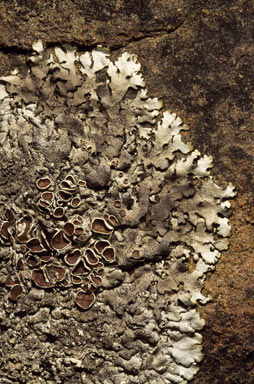 |
(click to enlarge) |
|
In the current scheme of classification there are hierarchies. Species that are thought to be more closely related to each other than to any other species are grouped into the one genus. Genera that are thought to be more closely related to each other than to any other genus are gathered in the one family and one can go a few steps further. Parmelia, the segregate genera listed above and various other genera were grouped into the family Parmeliaceae. The genus Chondropsis had been defined in 1897 to contain the VAGRANT LICHEN Chondropsis semiviridis ![]()
![]() and a second species (Chondropsis sorediata) was described in 1987. Chondropsis, though it grew unattached, was also classified in the Parmeliaceae. Note that Chondropsis had not been segregated from Parmelia.
and a second species (Chondropsis sorediata) was described in 1987. Chondropsis, though it grew unattached, was also classified in the Parmeliaceae. Note that Chondropsis had not been segregated from Parmelia.
 Most people would be aware that over the last few decades genetic testing has become very common and it is used in taxonomy. This issue is discussed at greater length on the CLASSIFICATION page so there will be the briefest of explanations here. Essentially, there are techniques for determining how similar is the DNA of various species. Suppose we have four species and we've found that the DNA of species 1 is very similar to that of species 2, that of species 3 is very similar to that of species 4 but that there are significant differences between the 1,2 pair and the 3,4 pair. We could present these findings visually by the diagram on the right, reminiscent of a human family tree. Now, suppose there are two lichen genera (X and Y) that have been defined on the basis of chemistry and morphological features. Suppose X has three species (call them a, b and c) while Y has four species ( called D, E, F and G). If, after DNA analysis we have a diagram like the left one of the following pair we'd conclude that the DNA evidence supports the idea of X and Y being two distinct genera. On the other hand, if the tree on the right resulted we'd say that the DNA evidence does not support the idea of X and Y as distinct genera since the species are intermixed in the second tree.
Most people would be aware that over the last few decades genetic testing has become very common and it is used in taxonomy. This issue is discussed at greater length on the CLASSIFICATION page so there will be the briefest of explanations here. Essentially, there are techniques for determining how similar is the DNA of various species. Suppose we have four species and we've found that the DNA of species 1 is very similar to that of species 2, that of species 3 is very similar to that of species 4 but that there are significant differences between the 1,2 pair and the 3,4 pair. We could present these findings visually by the diagram on the right, reminiscent of a human family tree. Now, suppose there are two lichen genera (X and Y) that have been defined on the basis of chemistry and morphological features. Suppose X has three species (call them a, b and c) while Y has four species ( called D, E, F and G). If, after DNA analysis we have a diagram like the left one of the following pair we'd conclude that the DNA evidence supports the idea of X and Y being two distinct genera. On the other hand, if the tree on the right resulted we'd say that the DNA evidence does not support the idea of X and Y as distinct genera since the species are intermixed in the second tree.
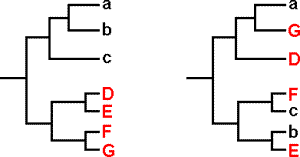
DNA analysis of specimens of 58 parmelioid species was published in 2004 and the following diagram is a simplification of part of a figure that appeared in that paper. In the original each species is indicated separately but in my diagram I have used black blocks to indicate that a number of species of the one genus group together at that point and so I do not present all the fine detail of the original. The letters indicate these genera: C=Chondropsis, K=Karoowia, N=Neofuscelia, P=Paraparmelia, X=Xanthoparmelia and Xm=Xanthomaculina. Karoowia and Xanthomaculina had been defined in the 1980s and, like Chondropsis, had not been segregated from Parmelia. The bracketed numbers indicate the numbers of species grouped at each point.
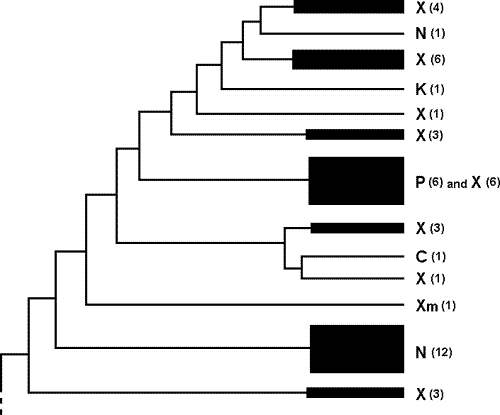
|
Though this diagram lacks the fine detail of the original, it suffices to show that species of the parmelioid genera just listed intermix as far as the DNA evidence published in 2004 is concerned. This is analogous to the situation summarised by the right hand diagram of the previous pair, namely that what had been defined as distinct genera on the basis of various chemical and morphological features could not be regarded as distinct on the basis of DNA evidence. As already noted above, resemblances between some of these genera had been pointed out many years before and in more recent years there had been additional non-DNA evidence that cast doubt on the distinctness of those genera from each other. Just as genera can be split or segregated from other genera so two genera can be combined. If genus A is found to be identical to genus B then the two can be united. There are rules regarding which name will be used for the combined genus but it is not important to go into that issue here. For the sake of argument, suppose that genus name A is the one that will be used. Then the species in genus B would be renamed and it would be said that B has been synonymized with A. The evidence presented in the paper of 2004 suggested that the genera Chondropsis, Neofuscelia and Paraparmelia were not distinct from Xanthoparmelia. The authors refrained from drawing any conclusions about the genera Karoowia and Xanthomaculina until further analysis was done. Proposals for synonymizing Chondropsis and Paraparmelia with Xanthoparmelia had been published earlier and so the 2004 findings regarding those genera caused no argument. However, the suggestion that Neofuscelia be synonymized with Xanthoparmelia was questioned by some lichenologists and some later work has suggested that while some species of Neofuscelia would belong in Xanthoparmelia, others would not![]() .
.
While it's clear that there's still more work to be done on the taxonomy of Xanthoparmelia and related genera, it's also clear that techniques such as chromatographic analysis and DNA methods, developed during the latter half of the 20th century, have been crucial to a sound understanding of the genus Xanthoparmelia. However, even if those techniques had been fully developed by the 1950s it would not have been possible to properly document the genus since it is most diverse in Australia and southern Africa. By the 1950s both of those regions had been little explored from a lichenological aspect. It was only the extensive field work in those areas in the 1960s and later that has provided the specimens to reveal the great diversity of Xanthoparmelia.
![An Australian Government Initiative [logo]](/images/austgovt_brown_90px.gif)


